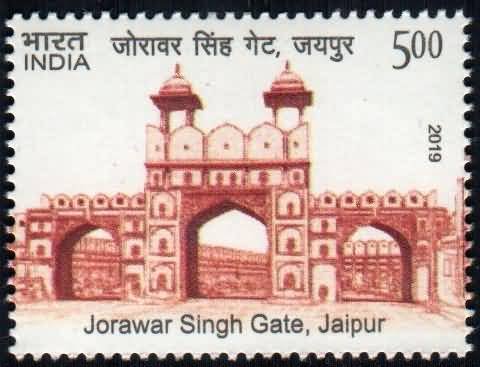Jorawar Singh Gate, Jaipur

Technical Data
| Stamp Set | Historical Gates of Indian Forts and Monuments |
|---|---|
| Date of Issue | October 19, 2019 |
| Denomination | Rs. 5 |
| Quantity | 500,000 |
| Perforation | 13¼ x 13¾ |
| Printer | Security Printing Press, Hyderabad |
| Printing Process | Wet Offset |
| Watermark | No Watermark |
| Colors | Multicolor |
| Credit (Designed By) | Sh. Brahm Prakash Sh. Pallab Bose |
| Catalog Codes |
Michel IN 3597A Stamp Number IN 3165 Yvert et Tellier IN 3275 Stanley Gibbons IN 3677 |
| Themes | Fortresses / Strongholds | Gates |
Gateway to the Walled City of Jaipur
The Jorawar Singh Gate, also known as the Zorawar Singh Gate, is one of the most prominent and historic entrances to the walled city of Jaipur, Rajasthan. Constructed during the reign of Maharaja Sawai Jai Singh II, the founder of Jaipur, this magnificent gateway reflects the city’s royal legacy and architectural brilliance. Jaipur, established in the 18th century, was designed with meticulous planning, and its gates were strategically positioned to safeguard the city and regulate movement.
Architectural Significance
Situated on the northern wall of the old city, the Jorawar Singh Gate stands as the widest of all Jaipur’s gates. It leads directly to the Amber Road, which connects Jaipur to the historic Amber Fort. The gate is named after General Zorawar Singh, a distinguished commander who served the Jaipur royal army.
The structure is an excellent example of Rajput architecture, showcasing ornate arches, symmetrical design, and traditional motifs. The gate’s grand façade, adorned with floral and geometric patterns, reflects both aesthetic beauty and defensive strength hallmarks of Jaipur’s walled architecture.
Historical and Cultural Importance
The Jorawar Singh Gate served as a crucial entry and exit point for royal processions, traders, and travelers heading toward Amber. It was also a symbol of protection and prestige, marking the boundary between the royal inner city and the surrounding settlements.
Beyond its strategic purpose, the gate represents Jaipur’s rich urban heritage. Each gate of the Pink City was associated with a specific direction, deity, or historical figure, and the Jorawar Singh Gate, aligned with the north, was linked with the Dhruv Tara (Pole Star) — signifying steadfastness and guidance.
A Walk Through Time
Today, the Jorawar Singh Gate welcomes visitors into a vibrant part of Jaipur filled with traditional markets, old havelis, and temples. Passing through the gate feels like stepping back in time — where the past coexists with the present in perfect harmony. It remains an integral part of Jaipur’s daily life, bustling with local activity while retaining its old-world grandeur.
Commemorative Postage Stamp
To celebrate India’s architectural legacy, the Department of Posts issued a commemorative postage stamp on the Jorawar Singh Gate, Jaipur, under the series Historical Gates of Indian Forts and Monuments.
This stamp highlights the cultural and architectural splendor of the gate, paying tribute to Jaipur’s enduring heritage and its timeless connection between royalty, defense, and design excellence. The Jorawar Singh Gate continues to stand tall — a majestic sentinel of the Pink City’s glorious past.

Leave a Comment
You must be logged in to post a comment.